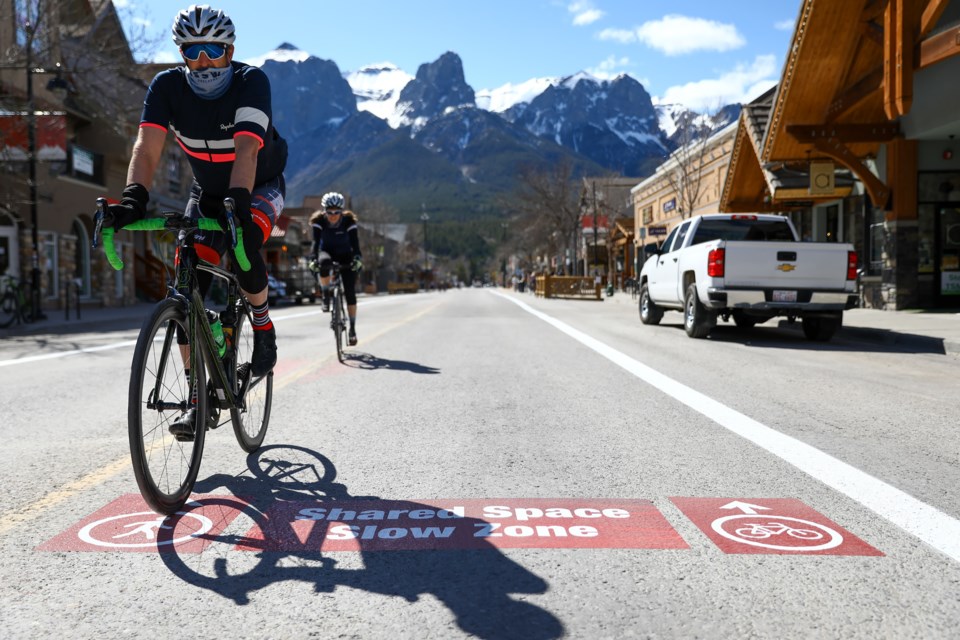CANMORE – Drivers in Canmore will need to keep an eye on their speedometers and a lead foot off the gas pedal.
Reduced speed limits will soon be implemented on most roads in the community. The move was originally recommended in the 2018 Integrated Transportation Plan and $200,000 was set aside in the 2023 capital budget.
All local roads in residential areas and collector roads that help move traffic from local to arterial roads will be 30 kilometres an hour. Arterial roads, which are meant for high amounts of traffic such as Bow Valley Trail, Three Sisters Drive and Benchlands Trail, will remain 50 km/h.
Claire Ellick, the Town’s transportation engineer, said statistics from the World Health Organization show a 90 per cent rate of survival for a pedestrian if struck by a vehicle going 30 km/h compared to less than 20 per cent if it is travelling at 50 km/h.
“The probability of someone walking being fatally injured in a collision with a motor vehicle also increases significantly as vehicle speeds go up,” she said.
The intent of the reduced speed limit is to provide more safety and encourage walking, cycling and taking public transit.
Historically, roads in North America were mainly built with vehicles in mind, but a staff report notes that greater safety is needed with the Town of Canmore prioritizing more active modes of transit.
“When reviewing pedestrian safety from a systems point of view, it becomes necessary to consider the many factors which expose pedestrians to risk. These may include factors such as the infrastructure available for walking, vehicle speeds, and road design among others,” stated the report.
Currently, the default speed limit in Canmore unless posted otherwise is 50 km/h. However, research has shown driver speed and collisions have a correlation with the seriousness of injuries.
“There has been a corresponding shift in standards and best practice to emphasize safety and human life over convenience,” stated the report. “Many cities and countries around the world have moved forward with the application of reduced speed limits in urban areas to address the more than 270,000 (as of 2013) pedestrian deaths that occur globally each year because of collisions involving motor vehicles.”
The work to change the speed limit signs is anticipated to be completed before summer, with an education campaign to be launched by the Town at the same time. Town staff will also look for areas where traffic calming measures can be introduced or added, such as speed trailers, concrete medians, signage and curb extensions.
Ellick said Town staff will be monitoring the changes before and after the switch to see how driver behaviour adjusts to the new rules.
She said it could be more difficult to identify some driver changes, but could “be reflected in overall mode shift and behavioural change over time.”
Canmore RCMP will continue as the main enforcement for speeding, but council's approval earlier this month allowing municipal enforcement officers to issue speeding tickets means the two organizations will work with one another.
The report highlighted the 30 km/h areas are not able to have photo radar. However, the report stated it’s not believed it would have an impact on photo radar revenue and an increase in fine revenue is expected for municipal enforcement.
Banff council approved a town-wide speed limit of 30 km/h early in 2022 to improve community safety. Other nearby communities such as Airdrie and Cochrane have adopted 30km/h speed limits in residential areas, while Toronto and Vancouver have the same speeds for residential and collector roads.
In a separate report to council, photo radar was shown to observe only two per cent of vehicles going above posted speed limits, showing a high number of drivers obeying speeding laws in the municipality when being recorded by photo radar
“The 98 per cent of people do follow the speed limits, according to the information we have, so I expect people will adhere to new rules and there will be some outliers, but I’m very thankful this is happening,” said Mayor Sean Krausert. “Our neighbourhoods are going to be safer because of it.”




